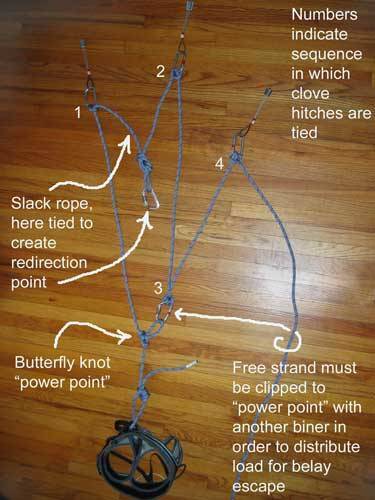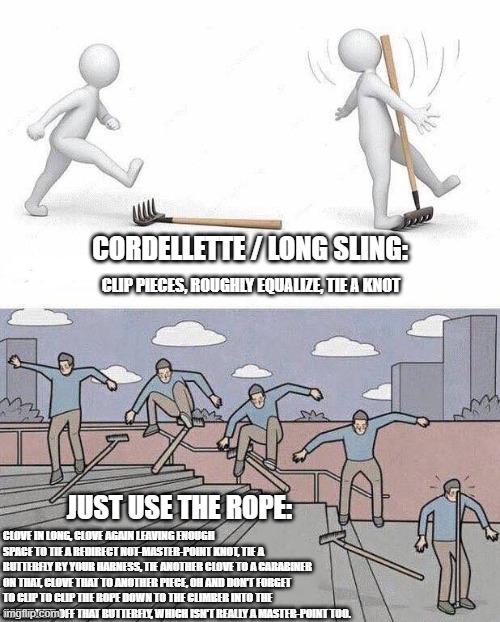To cordellette, or not to cordallette, that is the question
|
|
Why do some people seem so disgusted by the concept of bringing a decent length of cordage on multi pitch Trad climbs? I enjoy the flexibility and utility of my corsage and use it religiously. I am a new Trad climber focusing on safety, redundancy, and methodology when building belay anchors. I’m not particularly concerned with speed and my rack is super overdone. I know the weight cuts into my climbing ability but I’m old and have numerous ways injurious from other activities so I protect myself and my climbing companions with lots of carefully placed pro, and try to plan for all eventualities. The prussik cords, rap rings, and extra disposable webbing all serve a purpose. When Trad climbing a multi pitch route without a cordellette, how do you build redundant equalized anchors without using up all your runners? Please share your opinions and ideas here, but keep it constructive. Thank you |
|
|
Bruh, you need to ditch that weighty cord and get with the times! Modern climbers only climb with a Gri, a quadruple rack of cams, a Petzl adjust PAS, and 6 Microtraxions, all on mussy equipped routes. Just kidding, a cordelette is a perfectly useful and versatile piece of gear to bring on non-bolted routes, especially if you want to be prepared for the unexpected. The rope can be used to build anchors too, by the way. |
|
|
I used to carry a cordelette. I use a 240cm sling these days. It is easier to rack and handle in my opinion. |
|
|
Adventure climbing without bolted anchors =cord, sometimes just rope. Bolted station routes are rope or sling anchor. Lots of videos on different anchors out there with all kinds of options. Keep it serene with whatever you build. |
|
|
Cordelettes are useful for guides and others if one person is going to do all the leading, and for parties leading in blocks so that the same person leads a bunch of consecutive pitches. Many folks learn from guides and so assume that cordelettes are essential. For parties alternating leads, rigging an anchor with the rope is no slower, more robust, more adjustable, and more adaptable. For three or more anchor points it is better with two exceptions. (1) it consumes some of the climbing rope, which in some situations could be problematic if the leader has to stretch the last inch out of the lead. (2) It is badly suited to situations in which the belayer is positioned far from the anchor. Some people would add (3) that belay escapes are harder, but this doesn't seem to be the case to me. The picture below shows a more-or-less universal rigging protocol that works for virtually every anchor configuration. The "slack rope, here tied to create a redirection point" is an optional enhancement. |
|
|
I carry more single and double length slings than most modern sensibilities allow. I don't like cordalettes because of the bulk and the endless screwing around some people engage in when aiming for that "perfect" arrangement. I mostly just tie in with the rope, per rgold above but will use slings and even the occasional sliding-x incorporated. You say you're not concerned with speed and maybe your multi-pitch routes are short enough you're not in a race with daylight on the descent. But on a 10-pitch route if you take 10 minutes longer per pitch to set your belay, and you will, that's more than an hour and a half messing around with cordage and that hour and half may mean darkness on the descent. There's lots of exceptions of course but I try to keep my belay anchor setup to less than 5-minutes. |
|
|
FFS, go out and do your thing, Aaron. |
|
|
Rgold, is there a full write up on that configuration? I'm curious about the redirect point. This looks similar to what I've done in the past except I place the butterfly fairly far from myself and use it as a masterpoint for bringing my follower up. Then once they take next pitch I belay as normal from my harness. Would the redirect be for folks belaying a follower up via Grigri and/or routing for the rope when belaying a leader starting up the next pitch? |
|
|
I take cordelette on multipitch trad climbs. If the pieces are far apart it's the fastest and most convenient option for me. If they're close I use a sling or the rope. Bonus, I have lots of cord if I need to leave some tat. I use that 5.5mm Titan cord stuff. It doesn't last as many years but it's way, way less bulky. |
|
|
I used to carry cord more, but now only when I think I’m going to have to leave it behind. Otherwise I can usually easily make due with an assortment of dyneema slings (up to 240). |
|
|
Wow. That arrangement using the rope looks far more complex than almost anything I have ever rigged a belay anchor with, even if I’m tying two sliding ax’s with stopper knots AND a micro quad to bring it all together. I can build a 40+ kN bomber with nuts and cams which is equalized and redundant in less than 5 minutes. Yes it uses some gear, but it is sexy and safe. I will look into that system using the rope but it looks like it uses a shit ton of rope… (now I know why everyone is buying 70 meter ropes) j/k… It’s great that you don’t need a bunch of gear, I get that. I have been studying the books “Advancer Rock Climbing Techniques” by Bob Gaines, and I don’t recall seeing that. It just looks super complicated. I carry a heavy bulky cordellette and so does my follower. When we re rack at a belay station I take her cord for the next anchor build and leave her safely and securely tied in to the existing one. If I screw up and take a fall it’s never on the anchor, always on another (hopefully) solid piece above the anchor to negate the chance of a factor two. Thanks for the feedback friends! I appreciate the enlightenment. |
|
|
rgold wrote: this is really interesting rgold, thanks for posting this pic. when using the rope as an anchor, ive frequently seen the strands between pieces 1 and 4 tied into a masterpoint. if you have time, i’d love to hear an elaboration on the benefits of this setup. thanks! |
|
|
240 dyneema slings are very popular in the uk but I've never entirely understood why, for single pitch stuff I'll generally use a rope but for multipitch I prefer a nice long cordellete, I have been using bunny ears but have recently been using an open cordellete and have found it to be a pleasure to use. I generally dislike ropes for everything but simple single pitch anchors. For nicely bolted anchors I use sliding x(or quad if you want to be safer) with limiter knots which I keep round my chest, if the bolts are chained i generally won't back it up. There are a million ways to skin this cat, I wouldn't get too hung up on it. |
|
|
Aaron sounds like your methods are totally working for you. Climb on buddy. |
|
|
Aaron Gregory wrote: You might be confusing a lack of familiarity with complexity. It's not complicated at all and by most rational measures of complexity it is probably simpler than anything rigged with multiple slings and sliding x's as well as being stronger, more resilient, and not having knots that are hard to untie. It doesn't take any longer to set up and breaks down a bit faster than a cordelette . One of many advantages is that you rig the same way for almost every situation, rather than fussing around with ad hoc solutions for each anchor. If the belayer has to be far from the anchor, then it does use too much rope, which is why I said I carry a very light cordelette for those occasional situations. If we are speaking of a three-piece anchor, it basically consumes as much rope as three times the distance of the belayer to the anchor. So if the belayer is three feet from the anchor, it will use up ten feet of rope. If two belays are set up this way, twenty feet of rope are consumed. If you are climbing on 60 meter (200 ft) ropes, you're sacrificing 20 feet to the anchors and can only do a 180 ft lead. This has worked just fine for me for thousands of climbs, no need for a 70m rope, but YMMV. Here's another take: it is probably just a matter of time before you end up at a belay stance without your cordelette (maybe you dropped it, maybe you left it on the previous anchor) and without enough slings to replace the cordelette. Knowing the method I illustrated, you won't even be slowed down. I'm not doctrinaire about this or any other anchor method. The vast majority of anchor rigging is never tested anywhere near its limits, so almost anything you do is going to "work for you," as Mr. Nunes suggests. Place good gear and tie it together and things will be fine almost all the time, and no system is going to turn a bunch of bad placements into a good anchor. |
|
|
Aaron Gregory wrote: No you can’t. |
|
|
|
|
|
Desert Rock Sports wrote: It is interesting to me that someone went to the trouble to create that graphic, I suspect without actually trying out the method in practice. A great service to the climbing community. But whatever, the result is proof positive that the method I pictured takes more words to describe (and they got some of the steps wrong) than the cordelette method, especially when a whole bunch of steps in using the cordelette aren't described at all. (Consider, for example, the convolutions involved in "adjusting" a strand that comes out too loose---something that never happens with the rope method. Or the cautions about positioning the cordelette knot so it isn't in the way of the powerpoint knot. Or the kludges when one of the pieces is too far away, and the other kludges when all the pieces are too close together and the cordelette hangs down too low, as well as inserting carabiners in various knots so that they can be untied.) |
|
|
I'm with Aaron. With all due respect to RGold, my experience does not match yours. I use an open cordelette with overhands on a bite at each end. It's infinitely versatile, and very quick to set up and take apart. If/when my partner and I forget to pass second cord to the new leader, the leader will build anchor with rope and slings. Just because I use a cordalette, doesn't mean I'm not familiar with alternate options as necessary. |
|
|
I think it really depends on how many are the in the party and whether the leads are being swapped. The rope technique works really well with a party of two that are swapping leads. If the party is more than two or the leader is the same then the cordelette/long sling is more efficient. It's good to know how to build both. |
|
|
that guy named seb wrote: this |

 Continue with onX Maps
Continue with onX Maps Sign in with Facebook
Sign in with Facebook

























